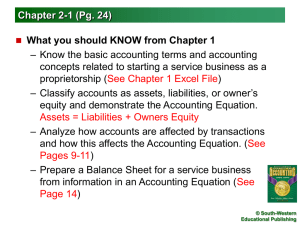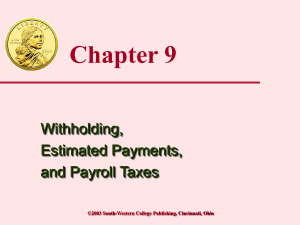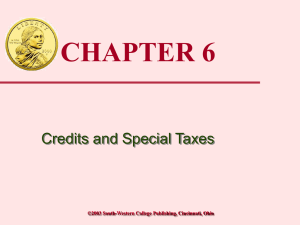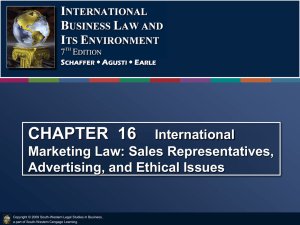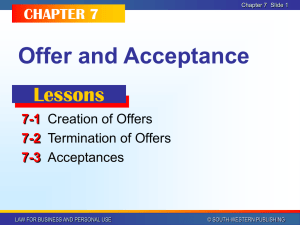Chapter 2
advertisement
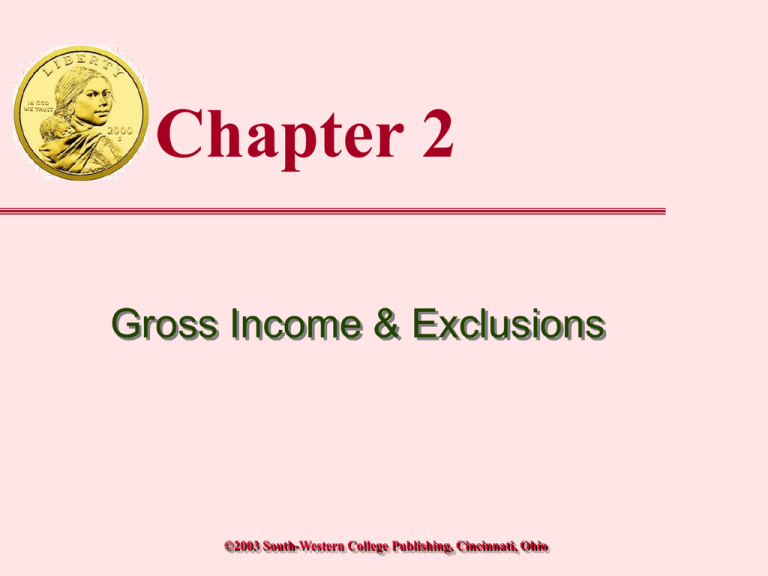
Chapter 2 Gross Income & Exclusions ©2003 South-Western College Publishing, Cincinnati, Ohio Objective Know the definition of Gross Income © 2003 South-Western College Publishing Transparency 2-2 Income Classifications All sources of income are included unless specifically excluded Non-cash items recorded at fair market value There are three classifications of income: Active - salary, wages and self employed Portfolio - dividends and interest Passive - real estate and limited partnership Can only offset passive losses against passive gains Can carry forward losses to future years © 2003 South-Western College Publishing Transparency 2-3 Objective Be familiar with the tax treatment of significant elements of gross income © 2003 South-Western College Publishing Transparency 2-4 Interest Income Must report interest earned on Form 1040, Schedule B if total interest income >$1,500 Data from brokerage statements and/or 1099-INT Sometimes interest is called dividends credit unions, money market accounts, co-ops, etc. © 2003 South-Western College Publishing Transparency 2-5 Municipal Bonds Interest earned on municipal bonds is taxexempt Attractive to high income taxpayers Calculation to compare yields When a municipal bond earns 6% (taxpayer in 30% bracket ) Need a taxable yield of [.06 / (1-.30)] = 8.571% © 2003 South-Western College Publishing Transparency 2-6 US Government Bonds (EE or HH) EE bonds Purchase at discount and then redeem for face value Can pay taxes on interest each year as value increases or all in year of redemption Interest is nontaxable if bonds are redeemed for higher education tuition HH bonds Issued at face value pay interest twice a year (interest taxed currently and no exemption for higher education) © 2003 South-Western College Publishing Transparency 2-7 Dividend Income 3 kinds of dividends Ordinary - return of corporate net income to shareholders (distribution of wealth) reflected on Schedule B when total dividend income > $1,500 Nontaxable - return of original investment (reduces basis in stock) Capital gain distributions - when mutual funds sell stock for capital gains taxpayers get capital gains distributions report on Schedule D, not Schedule B Data from brokerage statements and/or 1099DIV (cash or reinvested dividends) © 2003 South-Western College Publishing Transparency 2-8 Alimony To be alimony (deductible to payer, taxable to payee): 1. Must be in cash and received by ex-spouse 2. Must be made in connection with written instrument of divorce 3. Can’t be called anything else or contingent upon age/status of kids 4. Must stop with death of ex-spouse 5. Can’t live in same household as ex-spouse © 2003 South-Western College Publishing Transparency 2-9 Alimony (continued) Recapture provisions prevent front end load alimony payments Property transfer is not alimony because it’s not cash Transferor doesn’t have to recognize gain on property - but transferee’s basis is same as transferors © 2003 South-Western College Publishing Transparency 2-10 Child Support Not deductible by payer If payer falls behind on child support, must bring this current before any portion of payments considered alimony No income to payee © 2003 South-Western College Publishing Transparency 2-11 Prizes/Awards Taxable income equal to cash or FMV of property Exception: Employee awards of tangible personal property received for recognition of length of service or safety up to $400 (or $1600 if “qualified plan”) Example: employee receives a clock for 20 years of service valued at $1500. $400 is excluded and $1,100 would have to be included as income © 2003 South-Western College Publishing Transparency 2-12 Objective Be familiar with the tax rules for significant exclusions from gross income © 2003 South-Western College Publishing Transparency 2-13 Life Insurance Proceeds Generally tax free Unless the policy was transferred for value Except if transferred to partner in a partnership or officer in a corporation Taxable amount = Proceeds - Cash Surrender Value (at time of transfer) - Premiums paid by transferee Viatical settlements (when company buys out your life insurance policy knowing you are going to die) are excluded from income Death benefits excludable for terminally ill Excludable for chronically ill to extent used for long term care © 2003 South-Western College Publishing Transparency 2-14 Gifts/ Inheritances Gifts received are excluded from income Gifts in business settings usually considered income Inheritances are tax free to recipient © 2003 South-Western College Publishing Transparency 2-15 Scholarships Exclude amount received for fees, books, tuition, course required supplies or equipment Include in income Any amounts applied to room and board Any amounts received as compensation for required work Any tuition covered by scholarship may not be used towards educational credits © 2003 South-Western College Publishing Transparency 2-16 Accident/Health Insurance Premiums paid by employer on employee’s behalf for medical or accidental death and dismemberment insurance are excludable from gross income © 2003 South-Western College Publishing Transparency 2-17 Meals/Lodging Provided by Employer Exclude from gross income (1) meals provided by employer on premises during working hours solely for the benefit of the employer (2) lodging provided by employer on premises solely for the benefit of the employer and required as condition of job © 2003 South-Western College Publishing Transparency 2-18 Objective Be able to calculate taxable and nontaxable portions of annuity payments © 2003 South-Western College Publishing Transparency 2-19 Annuities/Pensions Definition: Taxpayer buys a contract (usually in retirement) in return for periodic payments for the remainder of life, or life plus survivor. Amount of annuity is based on purchase price and choice of life or life plus survivor © 2003 South-Western College Publishing Transparency 2-20 Annuities/Pensions (continued) Payments received are both taxable (interest) and nontaxable (return of capital) Employee contributions are never taxable as it’s a return of original investment Employer contributions always taxable Data from1099-R May show portion taxable and portion nontaxable or preparer may need to calculate) © 2003 South-Western College Publishing Transparency 2-21 Annuities/Pensions (continued) General Rule 1. Calculate exclusion ratio = Amount of Investment / (Annual payment x life expectancy) 2. Taxable amount = (1 - exclusion ratio) x annuity received © 2003 South-Western College Publishing Transparency 2-22 Annuities/Pensions (continued) Simplified General Rule If annuity started after 11/18/1996, taxpayer must use fill in worksheet provided by IRS unless: 1. The annuitant is age 75 (and certain other requirements are met, and 2. Annuity is a nonqualified plan annuity. © 2003 South-Western College Publishing Transparency 2-23 Annuities/Pensions Example Example Din invested $750,000 into his retirement account. His annuity pays $4,800/month. He’s expected to live 19 years. How much is taxable in the first year of retirement? Assume that Din is required to use the general rule. Answer $750,000/($4,800 x12 mo X19 yr) = .685 exclusion ratio .685 = 68.5% of pension is excluded from tax .685 x ($4,800 x12) = $39,456 total annuity $57,600 exclusion (39,456) taxable $18,144 © 2003 South-Western College Publishing Transparency 2-24 Objective Understand the rules governing inclusion of Social Security payments as income © 2003 South-Western College Publishing Transparency 2-25 Social Security Amount that is taxable is based on total AGI Before 1984 completely excludable From 1984 -1993 up to 50% of benefits may be taxable From 1993 forward up to 85% of benefits may be taxable © 2003 South-Western College Publishing Transparency 2-26 Social Security Calculate modified AGI (MAGI) AGI + foreign income + tax-exempt interest If MAGI + .5(SS) < base amount, benefits are not taxed If > base amount, must compute taxable portion © 2003 South-Western College Publishing Transparency 2-27 SS - Calculating Taxable Amount: 50% level If (MAGI + 50% SS) is between lower base and upper base amounts (below) Lower Upper $32,000 $44,000 MFJ $ 0 $ 0 MFS $25,000 $34,000 All others Taxable amount is lesser of: (a) 50% of SS or (b) 50% (MAGI + [.50% x SS] - Lower Base) © 2003 South-Western College Publishing Transparency 2-28 SS - Calculating Taxable Amount: 85% level If (MAGI + 50%SS) is greater than upper base, Taxable amount is lesser of: (a) 85% x SS or (b) 85% (MAGI + .50[SS] - upper base) plus lesser of: (i) 50% level formula or (ii) $4,500 ($6,000 for MFJ) © 2003 South-Western College Publishing Transparency 2-29 SS Example Holly is single. She has taxable pension of $22,000, tax exempt interest of $10,000 and receives SS benefits of $8,000. Her MAGI = $22,000 + $10,000 = $32,000. First calculation finds that MAGI + .5(SS) = $36,000 (over upper base), so you must compute both levels: 50% level 85% level Lesser of: Lesser of: (.5)x(8,000) = $4,000 (.85)x(8,000) = $6,800 or or (.5)x(36,000 -25,000) = $5,500 (.85)x(36,000-34,000) = $1,700 Added to lower of: $4,000 or $5,500 Therefore: $1,700 + $4,000 = $5,700 © 2003 South-Western College Publishing Transparency 2-30 Another SS Example Sam has retirement income of $21,000 and SS benefits of $15,000. His wife Heidi also has retirement income of $10,000, dividends of $4,000 and SS of $11,000. Their combined MAGI = 21,000 + 10,000 + 4,000 = $35,000. MAGI + .50(SS Benefits) = $48,000, which is over upper base. Answer: 50% level to find amount to put in second formula lesser of (.50)x(26,000) = $13,000 or (.50)x(48,000 - 32,000) = $8,000 85% level to find taxable amount lesser of (.85)x(26,000) = $22,100 or (.85)x(48,000-44,000) = $3,400 plus the lesser of $8,000 (from above) or $6,000 (MFJ amount) Therefore, taxable amount is $3,400 + $6,000 = $9,400 © 2003 South-Western College Publishing Transparency 2-31 Some Fringe Benefits are Not Taxable No-Additional-Cost benefits Employee discounts unless discount is on real estate or the discount is > 20% Parking (up to $180/month is tax free) Working Condition - if you could deduct on your own as an employee Can exclude from income if company paid (for example - subscription to professional journal) de minimis fringe benefits (so small not worth keeping track of) Tuition reduction undergraduate - excludable if available to all employees graduate - excludable if currently teaching/researching at that institution © 2003 South-Western College Publishing Transparency 2-32 The End © 2003 South-Western College Publishing Transparency 2-33
